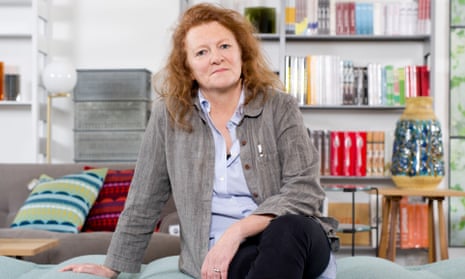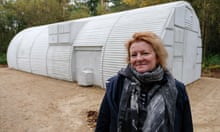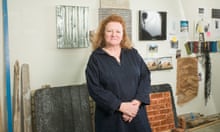Among Rachel Whiteread’s best-known works are House, a cast of the inside of a Victorian house which stood in Mile End Park until it was controversially demolished in 1994, and the Judenplatz Holocaust Memorial in Vienna. Whiteread won the Turner prize in 1993, the first woman to do so. A retrospective of her work took place at Tate Britain last year. Nissen Hut, her first permanent public sculpture in the UK, is a commission by the Forestry Commission and 14-18 Now, the arts programme marking the centenary of the first world war. Its home will be in Dalby Forest, North Yorkshire, from 10 October.
How did you come to make Nissen Hut?
Tamsin Dillon of 14-18 Now came to me and asked if I was interested in getting involved. I wasn’t sure initially what I might do, but eventually I suggested a building, one that would work well with the series of “shy sculptures” I’m doing internationally [a series of casts of small buildings sited in unexpected, out-of-the-way places]. It seemed right to use for a model something that had been developed by this rather extraordinary man, Major Peter Nissen. His huts [used by the military, primarily as barracks and hospital units] were exemplary structures, made from corrugated iron and balsa wood, and the model for future prefabricated buildings. But also, I’ve always been interested in the war. My father’s grandfather was a conscientious objector; on the other side, my great-grandfather was in the trenches, and suffered his entire life from the after-effects.
What’s your Nissen hut like? Did you cast from a real one?
There is one in the Dalby Forest, but it’s in a state of disrepair, and also the locals use it as a dog-walking shelter. So we couldn’t cast from it. But we used it as a model. It’s a long half-cylinder, very plain: an entrance and an exit, a fireplace at one side. I’m very pleased with it. Mine will be deeper into the forest than the one I modelled it on – they wanted it to be part of a Gruffalo walk, but I said no to that – and though there will be pathways, you will really have to find it if you want to see it.
Are people more receptive to this kind of public art than they used to be?
Yes, they are, and I think House had a lot to do with that. Some people are still scared of contemporary art, in a way that they aren’t of theatre or music. But over the past 20 years, they’ve become more and more educated about it.
You’re as interested as ever in making space solid, turning air into something tangible. Why does this idea continue to intrigue you?
If I knew that, I wouldn’t do it. I think it’s to do with invention and play, and the language you develop. It’s about the domestic, too. It’s just a part of my practice now, though unlike many artists, I play with scale, and that’s what I really enjoy doing.
You once said that some galleries are now just too popular. Do you stand by that?
Absolutely. And it has got worse, if anything. I really think twice about going to some shows, and I never used to be like that. It has become a form of entertainment, and while that has its good side, I suppose, for me as a practising artist, it’s a bit irritating. It’s a kind of funfair, and that’s not really my thing. With a big show like Picasso [at Tate Modern], I go in backwards: I start at the end. It’s easier, the rooms are more empty. All this is one reason why I put things in places that people have to make an effort to get to. I have very consciously made things that are about taking the time to look.
What do you make of #MeToo in relation to the art world?
The art world is extraordinarily accepting, and a lot of people have been able to get away with things, good and bad, because of that. There’s a kind of general leeway. People are able to do what they want behind closed doors – or people get involved in what you might call almost silent pacts. There are people, some very high-profile, whose behaviour has been brought into the limelight recently, and nothing has really happened because no one is prepared to speak about them – for many reasons. It’s very complicated. But it’s still a good thing these things come up if it makes people think, and behave better, and understand that you can’t get away with some of the abhorrent behaviour that went on in the last century.
What about its effect on the way artists’ work is seen? In New York, a woman recently campaigned to have Balthus’s Thérèse Dreaming [which shows a teenage girl’s underwear] removed from the Metropolitan Museum of Art.
Do I think Balthus’s painting should come down? No, I don’t. I don’t think Lolita should be banned either. If you start doing that kind of thing, where do you stop? It’s crazy. Artists have a right to express what they want. It’s free speech. Things can be offensive and you can be offended; galleries can have labels up saying “this isn’t suitable for… whatever”. But I don’t think things should come down, no.
You recently left east London, an area with which you’re strongly associated, and whose industrial architecture has inspired your work. It’s as if the ravens had left the Tower. Why did you decide to move?
We couldn’t stand Shoreditch any longer. It’s just a hellhole. I know we artists contributed to making it that way [gentrified, expensive, noisy], but it had become monstrous. Everybody I know has left: every good artist. I’ve moved back to where I grew up, which is north London. My studio is in Camden and I live in Highgate, near the Heath. Camden is less changed than Shoreditch, and all the more interesting for it, and Highgate is peaceful. There are trees. It’s lovely.








